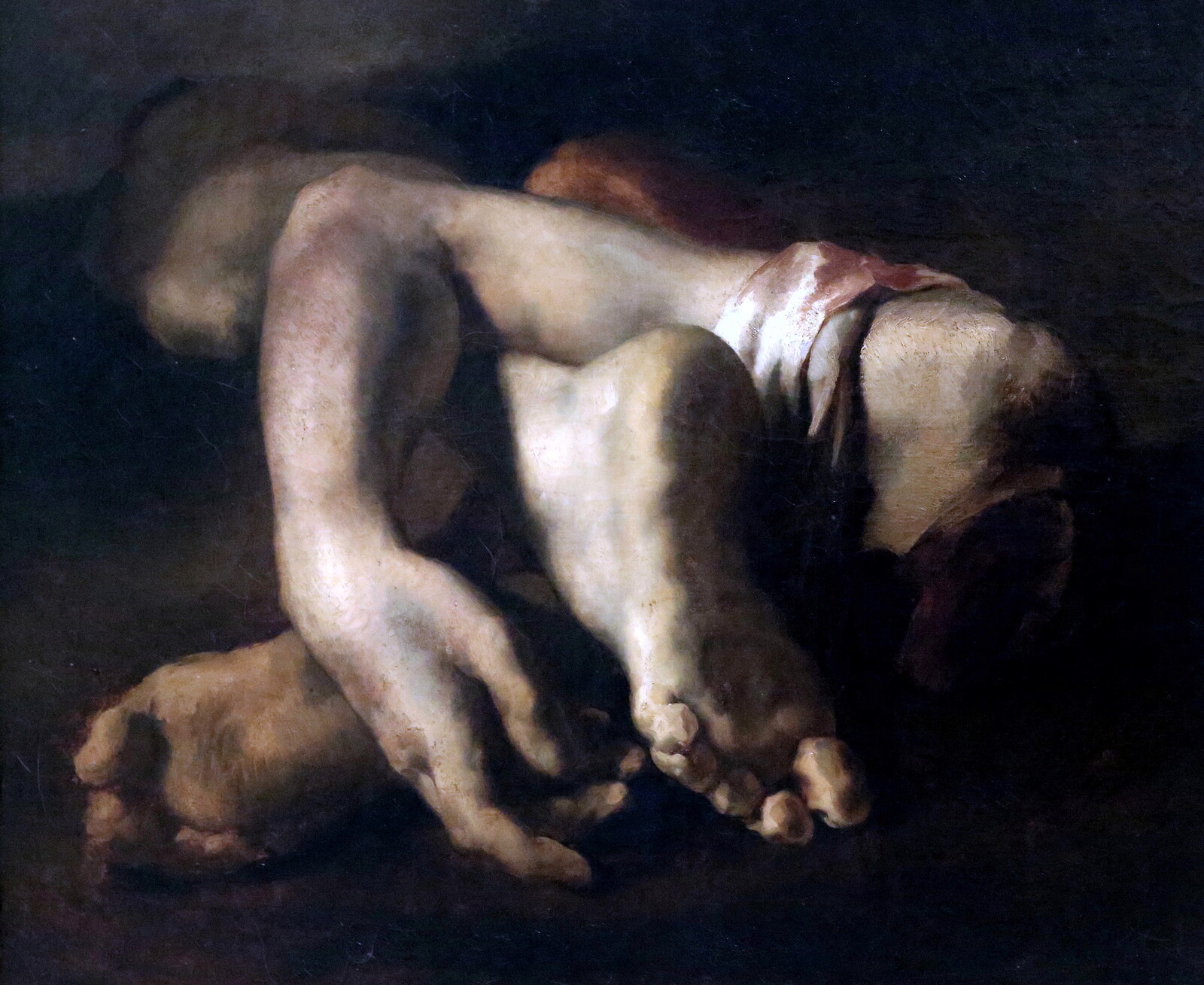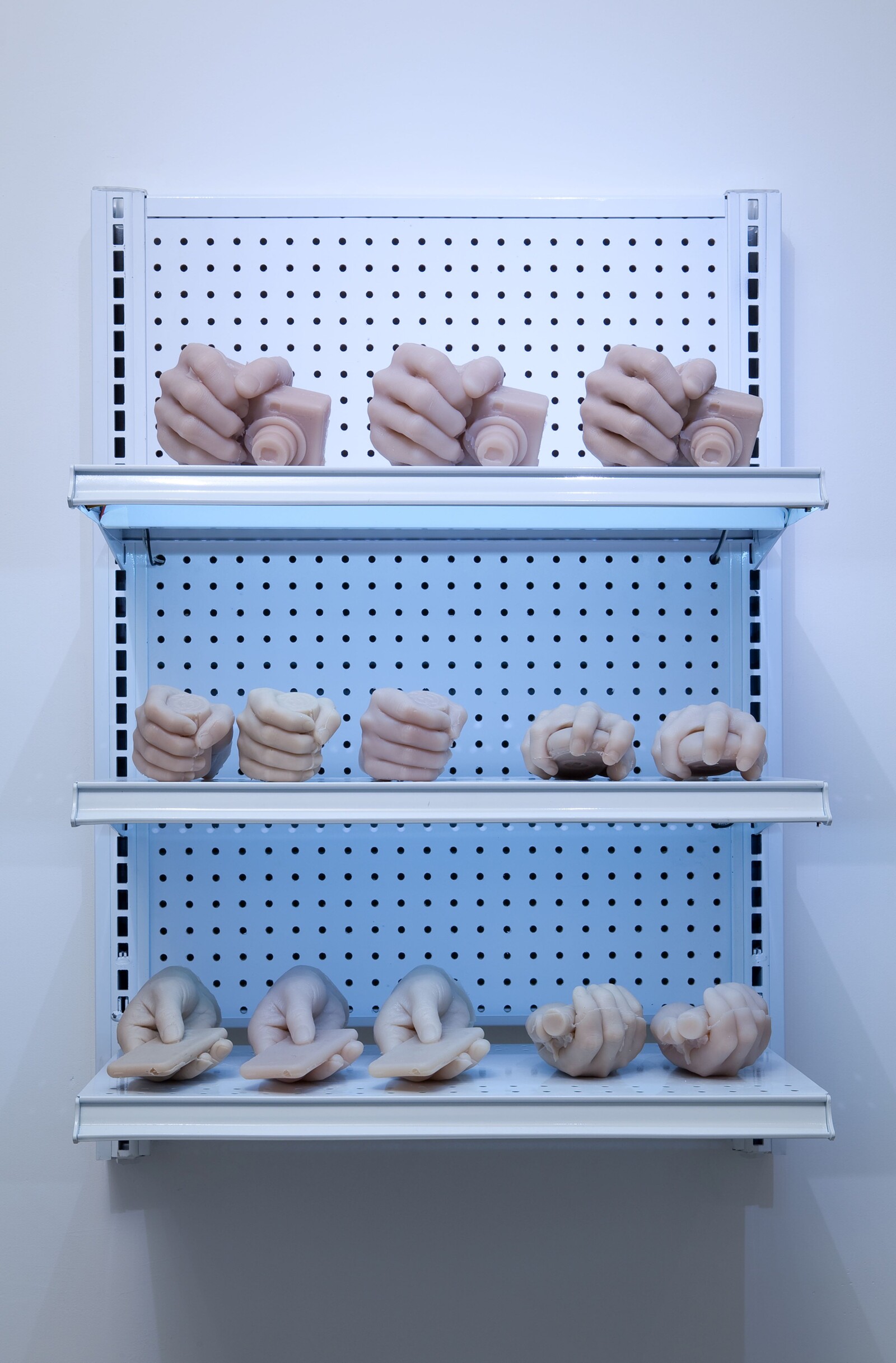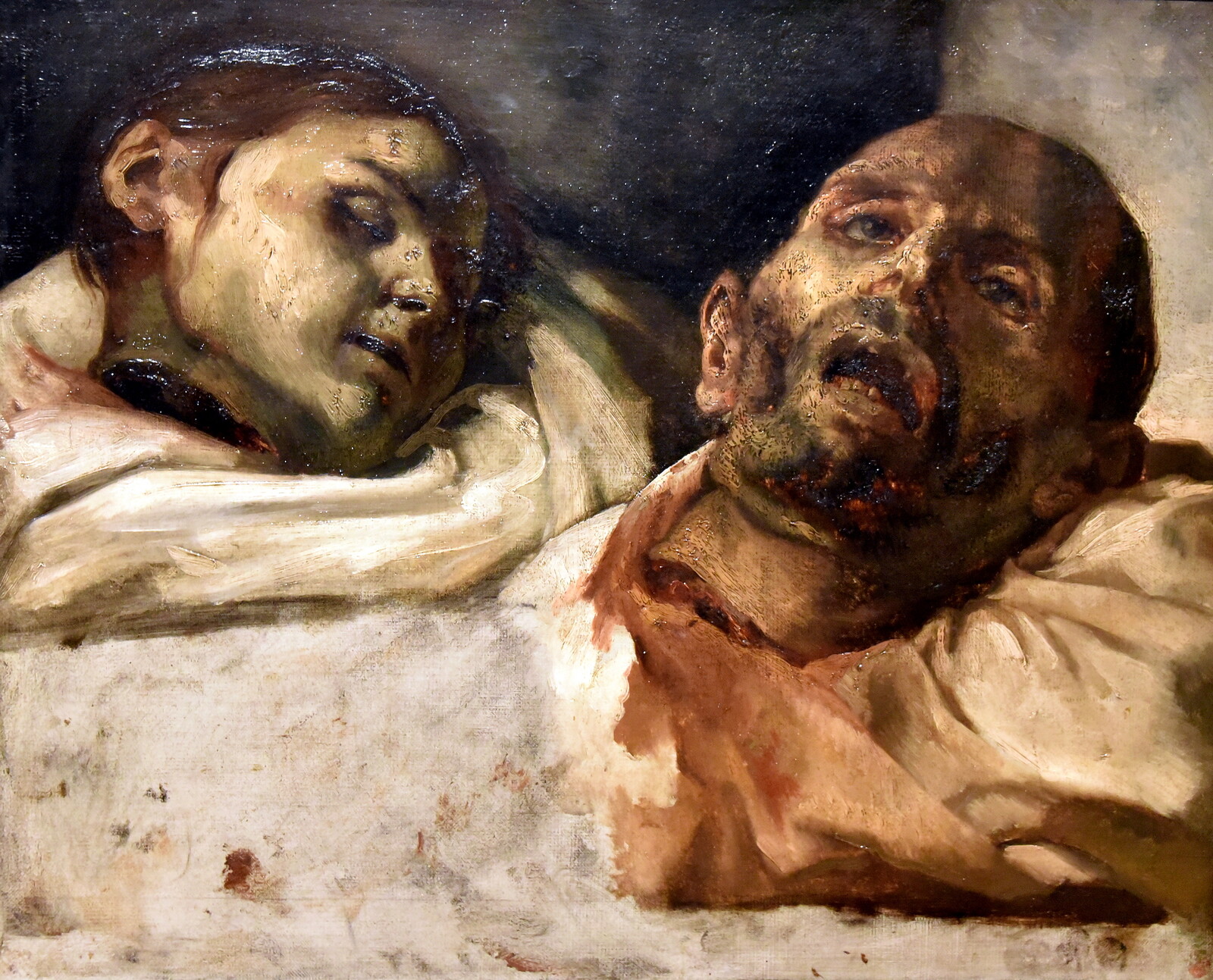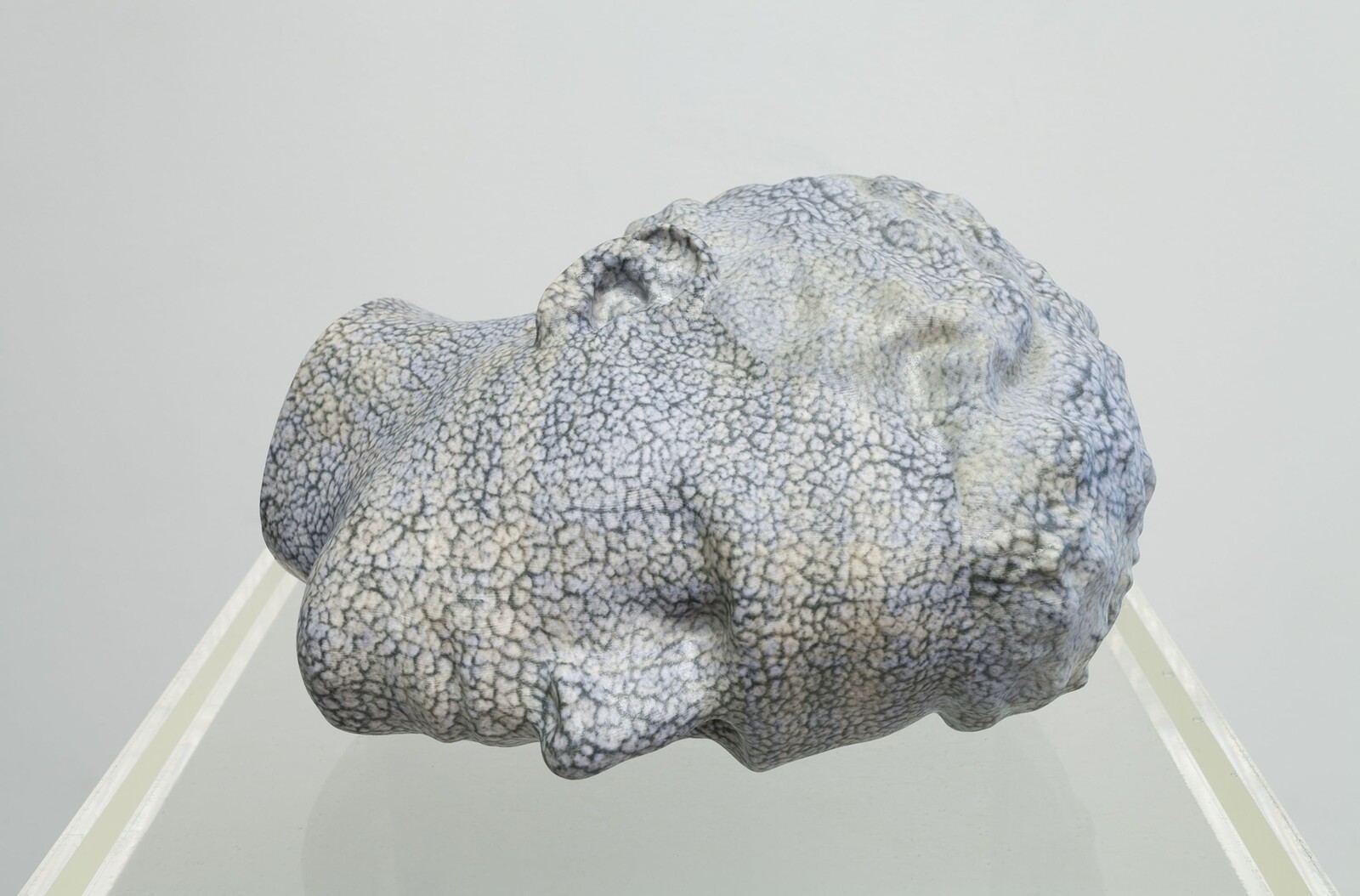Even during the best of times—a category for which the present certainly does not qualify—writing about art requires a certain suspension of disbelief. Simply engaging in criticism implies a vague normative claim about the social or political importance of elaborate and often expensive objects. It is a role that can be hard to defend even, or perhaps especially, when the objects claim a political position. But since looking cannot be separated from thinking, Josh Kline’s recent retrospective at the Whitney Museum of American Art (and its exuberant critical reception) merits some extra attention. Not because of the show’s “inscrutable lucidity,” or because the work’s position “between irony and sincerity” offers meaningful insight into the “propaganda it evokes.”1
The reason is far too simple to require such attempts to extract complexity from proximal antonyms. Americans spend enormous amounts of time consuming mediated violence, so when images of cut-up human bodies show up in a major art museum, we should pause and consider what exactly we are thinking as we look at the severed head of a waitress on a tray. Kline’s show was widely reviewed (the New York Times published two pieces about it, Artforum gave it the cover), and yet the fact that its most explicit attempt to examine or critique class politics in the United States involved piles of amputated limbs that were produced by copying the bodies of living people—“real workers”—has gone largely unremarked upon.
This is not the first time that an artist has chosen dead human body parts as a means of communicating political meaning.2 In the 1810s, Théodore Géricault produced several careful, realist images of severed heads, arms, and legs. Arranged atop gathered drapery on a horizontal plane in compositions resembling still lives, these naturalistically rendered heads are the unmistakable result of the guillotine. Nothing romantic, no repose, the mouths gape and the wide eyes look nowhere. There is a literal, journalistic, reading of this impulse: the revolutionary terror was not far in the past, at the time of painting, and execution by decapitation continued to be quite common. Attention to injury in his other works suggest that Géricault was interested in the bodily cost of the Napoleonic Wars and the disabled, incomplete, or fragmented body produced by poverty. He documented executions by hanging and carts full of corpses. His most famous painting, The Raft of the Medusa (1818/19), depicts the survivors of a shipwreck who were rumored to have engaged in cannibalism.
The history of art is full of death and dismemberment, but Géricault’s human-limbs-as-still-life stands out for its ghoulishness. It may be one of the most complete and literal objectifications of a human body on record. The naturalism resists metaphor. These are insistently human body parts, believably removed from a once ambulatory body. The index of a robust subjectivity—a fully human presence—makes the objectification unavoidable. His equation of an arm with a bouquet of flowers or pile of fruit is perhaps the closest we will get to witnessing the process of a subject becoming an object. The limbs are not rotten. The temporal proximity to their living, fully articulated body underscores the absence of the subject or consciousness. Every image of a person is an act of objectification, but rarely is objectification figured so clearly as the process through which subjectivity is lost.
Géricault also made several paintings of his own hands. Artist’s Hand (1823) is an image of just that, framed and titled as if detached from the artist as a whole, but gripping a stone—muscular, vital, capable. The threat of detachment is implied by the severed limbs and war-wounded bodies, but the ease of severance and the independence of the hand is striking in equal measure. The hand is an alienable, mechanical part that is both representative of the artist and essential to the subjectivity that it represents. A painter less hands is arguably not a painter any more. In a morbid and literal take on the humanism of the French Revolution—one perhaps tied directly to the fatal democracy of the guillotine—Géricault has depicted himself as radically equal to every other breakable body.
Kline’s 3D-printed copies of actual bodies are not nearly so dead and grisly, but their claims on reality are similar. The temporal proximity of Géricault’s severed limbs to a live body is an explicit relation to actual, fully articulated subjects. In Kline’s work, the relation of the limbs to full bodies is articulated through their relation to other images or documented names. These are the arms, feet, heads, faces, and hands of people that Kline has met and interviewed. His series “Blue Collars” (2014-20) consists of a series of interviews with people employed in the service industry. The subjects of the films answer questions posed by Kline about their incomes, aspirations, expenses, and families. Accompanying these interviews are sculptures made from 3D scans of the subjects’ bodies. The hand of a FedEx driver holds a scanner; the hand of an Applebee’s waitress holds a check; the arms of a Walmart employee lie in a shopping cart. Like Géricault, Kline’s hands also appear severed and reproduced. Here, however, the relation to the other hands and arms is less about materially similar bodies and more about differing social roles. The sculptures are intended as a commentary on the commodification of workers’ bodies by rendering the figurative fragmentation and objectification of bodies under capitalism in three dimensions, and exaggerating the ways that work can reduce a subject to its parts. Kline has been celebrated for this clear-eyed depiction of capitalism.
Géricault’s limbs must have smelled, and the psychic operation required to aestheticize and document an obviously rotting part of a body, to “report” on the heads hauled from the guillotine in carts, requires a mind shaped by the necessity of reconciling itself to a different form of pathological, social violence. One moment’s violence is not preferable to the other’s, but the differences are telling. Where the paintings are so very dead—the base materiality of human bodies emphasized by ragged flesh and the equation of an arm with the organic content of a still life—Kline’s sculptures are so very fake. The smooth surfaces and lack of bone and gore at the points of disarticulation reassure us that it is only a metaphor. The sanitation of the body parts by the accuracy of the 3D printing process, and the guarantee of ongoing life provided by the video interviews with the human sources, result in a particular form of realism that is at once a one-to-one copy of the reality it references and a guarantee that it is a mere simulation.
As a result, the audience and the artist can look at chopped-up women and men who work for them and consider the violence of a class system without ever noticing that they enjoy looking at the chopped-up bodies of the people who work for them. This exercise in voyeurism seems to be the only blunt metaphorical object that Kline did not intend to use. At a moment when the Metropolitan Museum of Art has annotated Thomas Cole’s landscape paintings to acknowledge how much violence can get hidden by an empty field, viewing a show (and then viewing, by way of reviews, the “art world” viewing a show) that claims to be directly addressing class, yet fails to see anything wrong with the visual pleasures of a sanitized pile of corpses is bizarre and distressing. Despite the overwhelming presence of violence as a subject in so much of Kline’s work, one wonders if the physical violence necessary to the production and dissemination of goods in a capitalist economy is being considered. It almost seems as if violence is being used as an effect here—an aesthetic category whose function is filling out Kline’s metaphors for capitalism, not encouraging viewers to think about the dramatic industrial accidents and slow deaths endemic to the production of middle-class American lifestyles. But it cannot be explained away as bad politics per se or the irony-poisoned “awareness” that soothes so many of our ethically schizoid souls. Kline is, if nothing else, earnest and well-intentioned.
What went so terribly wrong here (and what professional viewers dubbed perceptive and admirable) is a manner of reporting, a form of representation, a style that unselfconsciously reproduces the problem it claims to critique in the name of clarity. In his 1936 essay “Narrate or Describe?” Georg Lukács suggests that one of the many political failures of naturalism—in spite of its practitioners’ political positions—is that “description contemporizes everything.” Whereas narration recounts a past, description creates a spatial present that “confers a temporal ‘present’ on men and objects,” turning subjects who develop in time into “static situations”, or “still lives” (in French natures mortes, literally “dead nature”).3 This is central to what is unintentionally offensive and disturbing about “Blue Collars.” Rather than depicting bodies in time that were once alive and whole, both the body parts and the living bodies have been relieved of activity and turned into symbols that operate entirely outside of time—static, dead, interchangeable, and fully objectified.
The decapitated heads of two women who occupy typically female, often sexualized lines of work, a waitress and a maid, are particularly good examples of how this piece of art participates in the reification (the transformation of an abstraction into a reality) rather than the deconstruction of class positions. The Applebee’s waitress’s head rests on a black tray next to a burger labeled with her nametag. Jenn, an employee whose income is dependent on her ability to please customers, is, here, a literal piece of meat. Certainly, this tasteless metaphor was intentional. The maid’s head lies on a cleaning cart, signifying a mental capacity reduced to the tools of her unskilled trade. The decapitated FedEx delivery man in a box of packing peanuts is disturbing and insulting as both an object and a depiction of a human, but the women’s decapitated heads are inseparable from a vast representational economy of sexualized violence constructed and even enabled by the very objectification on display here. In this case it becomes particularly difficult to separate representation from the reality of gendered violence, and anyone armed, like Kline, with a background in visual anthropology should have accounted for this.
By ignoring the different meanings that violence takes on in relation to an individual’s person and circumstance, “Blue Collars” fails to even gesture at the substantial differences that exist among its subjects. As a result, it is merely a recapitulation of the very reduction that it claims to critique. There is no indication that Kline considered the way that hierarchical social relations might coalesce in and be reinforced by the commodities that he has created.
“Creative Hands” (2011) features Kline’s own hands holding a bottle of hand sanitizer along with the hands of his friends on a series of shelves that do not indicate where their creativity takes place—in other words, it does not define the subjects (who have first and last names displayed alongside their body parts) according to a specific workplace or type of work. The already problematic reproduction of a managerial hierarchy that marks the artists’ relationship to their subjects is underscored by this title emphasizing the intellectual labor of the artist/manager rather than the manual—hands only—labor of the “blue collars.” The signifiers of intellectual labor generate and reinforce the difference between hands that create and hands that work for FedEx. Why isn’t a waitress’s hand creative? Waitressing is hard. Balancing dishes is a skillful and exhausting enterprise. Maximizing tips in an Applebee’s requires a creativity and intelligence that far exceeds what is on display here. Of course, one can argue that Kline is merely representing the perverse valuations of a society that somehow concluded that day trading or art-making are more important and more difficult than delivering goods or feeding people. This is, surely, what the artist thinks he is doing.
But consider for a moment the implications of mimesis as a critical or aesthetic framework. Plato alerted us to the disturbing proximity of representations to lies when he banned poets from an ideal republic. This is easy to dismiss as a totalitarian impulse—a censorious and joyless exiling of figurative and creative thinking—but it also says something useful about forms of representation that make direct claims on reality. What is the difference between a great copy and a lie? What politically toxic ideas are being introduced by perfect replicas that appear to merely represent their subject? Of course, decapitated heads on servers’ trays can’t lay claim to any straightforward realism unless Kline’s subjects have actually been murdered (which renders any defensive retreat to “reality” incoherent in this case), but they can claim to represent the living subjects that inspired them. This is troubling. Are we to take it that the severed head of Jenn the waitress is, therefore, “really” Jenn’s head, reducing Jenn herself to a decapitated head on a tray, a piece of meat, etc.? That she has “literally” been commodified? From the perspective of capital, the problem with free labor, as constrained by circumstance as it may be, is that human beings will never actually become tradeable property. The popular misuse of the word “literally” seems here to have slipped from a bad habit of speech into a frightening political claim.
“The loss of the narrative interrelationship between objects and their function in concrete human experiences,” writes Lukács, “means a loss of artistic significance.”4 Translated into the language of a body, the loss of a relationship between a head and a whole subject that exists and moves though time is just such a lack. Jenn’s head, described in painstaking, naturalist detail by a 3D-printing technology, has no actual importance aside from its descriptive accuracy because a subject exists in time and their significance cannot be captured as surface effects. It shouldn’t need to be pointed out, but a subject has psychological motivations, and acts in relation to unfolding circumstances that exceed their material settings. Description provides several artistic and authorial (authoritarian) advantages. Emptied of specific significance, Lukács argues, “objects can then acquire significance only through direct association with some abstract concept which the author considers essential to his view of the world.” Significantly, an object does not “achieve poetic significance” in this way. Rather, “poetic significance is assigned to it.”5
Subjects becoming receptacles for simplistic misunderstandings of class is arguably the result of a simpler problem of documentary practice. Pointing your camera down—a bad artistic habit that is not unique to Kline—has many creative advantages. If you would like to maintain control and artistic integrity, it is safest and best if your subjects don’t have more power than you do. It is sickening to realize the extent to which this quiet economic coercion shapes a show that purports to critically address exploitation. The only real people interviewed are the working-class subjects of “Blue Collars.” Members of other classes—people with incomes and power more or less equal to the artist’s—are played by actors following his script.
In a lengthy profile in the New York Times, we learn that Kline “has little patience for the art world’s insularity, especially conceptual provocations that only make sense to those with an aesthetic theory decoder ring.” “You shouldn’t need four years of study of Lacan and Deleuze and Adorno and whoever to understand art,” Kline explained. “I want to create an art that’s accessible to the FedEx delivery worker or a doctor who doesn’t have that specific education but is interested in the society they live in.”6 This sort of everyman sentiment has won many people over, but the statement’s intuitive, common-sense appeal barely conceals an arrogance vis-a-vis other artists, intellectuals, and doctors, not to mention FedEx workers. Kline, we are meant to understand, is going to do a better job communicating important problems than his fellow “creative hands” because he operates in a simple language that can be understood by workers and non-artistic professionals alike.
As we know from the past several decades of presidential politics, disdain for intellectuals, combined with an ostentatious concern for those with far less money, is a hallmark of false populism. The fact is that Kline and his cohort (which includes me) have almost nothing in common with low-wage workers. It doesn’t matter that we might have come from a working-class household, our incomes are now above the national median. Losing sight of this reality results, not in empathy, but in a self-interested effacement of difference from which those with relative class privilege emerge with their individualism intact while poverty continues its brutal objectification. It is also a cheap way to make a lack of scholarly due diligence seem virtuous. “Blue Collars” can only present itself as a charitable act of inclusion if it entirely ignores a well-established art-historical tradition of gawking at the poor. Even more harmful and insidious is the failure to interrogate the impulse and implications of charity. A close reader of Adorno might have avoided some of these pitfalls. As for not needing Lacan and Deleuze, the dismemberment/castration obsession on display throughout the exhibition suggests otherwise.
The art historian Linda Nochlin suggested that the arms and legs and heads of Géricault can be read into a more general revolutionary and post-revolutionary concern with the fragment. In a moment of crisis, Nochlin argued, the fragment represented a tearing down and making anew. Kline’s fragments represent anything but the creative destruction of the status quo. “Blue Collars” instead poses as a statement of fact. It is not a new, unknown, fact. It is not a useful interpretation of said fact. It is a reinforcement of the fact. Without acknowledging that the severed limbs are themselves violent, it is difficult to see how such a milquetoast pseudo-analysis could be harmful. But “Blue Collars” is anything but neutral. In its cynical resignation to a hierarchy in which the artist and his creative cohort is named and acknowledged and Jenn’s head is served to them on a tray, it reinforces the class violence that it claims to redress and exonerates the guilty parties.
Travis Diehl, “Propaganda with an Ambiguous Message?: That’s Art,” New York Times (July 19, 2023); Colby Chamberlain on the art of Josh Kline, Artforum (April 2023).
For example, morgue paintings are arguably a genre in themselves. The Mexican artist and former pathologist Teresa Margolles has organized an entire practice around blood and other traces of murder victims. The bloody practices of the Viennese Actionists, while using mostly animal parts, are in a similar representational register. The number of artworks that consciously and unconsciously evoke amputation are countless. Fashion photography is all but defined by the severed limbs of women in particular.
Georg Lukács, Writer and Critic: and other Essays, ed. and trans. Arthur Kahn (New York: Grosset & Dunlap, 1971), 130.
Ibid, 131.
Ibid, 131.
Zoë Lescaze, “An Artist for the End of the World: What’s so funny about our dystopian future? Just ask Josh Kline,” New York Times (March 17, 2023).





